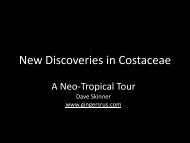You also want an ePaper? Increase the reach of your titles
YUMPU automatically turns print PDFs into web optimized ePapers that Google loves.
THE <strong>BULLETIN</strong> / JANUARY 2010 PAGE 5Guzmania teuscheri kept my attention in between H.griggsiana red and blueish wax until we came to a coupleof individuals with yellow instead of the mostly dominantred. Harry Luther from Marie Selby Botanical Garden hasmentioned recently these xanthic or yellow forms are commonin some bromeliads especially Guzmania. I guess weare seeing this in <strong>Heliconia</strong> as well. A good example beingthe yellow H. dielsiana we saw in the south. As weclimbed in elevation we were able to start spotting differentspecies starting with H. virginalis, H. pardoi and finallyat the top of the hill we started to see beautiful examplesof H. burleana some up to 3m tall with large red inflorescences.The next day we headed towards San Miguel del losBancos on two missions. Firstly Dave was keen to relocatea Costus he saw briefly a couple of years ago when hewas able to coax a bus driver to stop quickly so he couldjump out and take a photo before the bus took off. Seeingthe work of Ecuadorian bus drivers, Dave is either verypersuasive or lucky. I’ll leave it to Dave to one day documenthis discoveries and his captivity at high elevations.We travelled to the town of Pachijal and along the road wecame across another couple of <strong>Heliconia</strong> species that wehadn’t seen before - H. regalis (a large red form), and wewere lucky to finally find a flowering H. sclerotricha afterseeing hundreds of individuals but no flowers. We speculatedlong and hard what it could be with it’s lenticularmarkings along the pseudostems, common in the sectionObscurae, and fan style leaf arrangement similar to H.trichocarpa and others in the section Sigmoideae.The next area we were targeting was around thetown of San Miguel del los Bancos. This is the habitat andcollecting locality of one of the two patterned leaf heliconias,H. willisiana. I was lucky enough to see an individualof this species about 12 years ago at Mark Collins’sEden Farms Kurtistown farm halfway up the volcano onthe big Island of Hawaii. Mark’s farm was generallycloudy with a regular rainfall. The day we were in SanMiguel del los Bancos was pretty much the same. Ittook us a while asking lots of locals where the old roadto Santo Domingo was and we found that we needed tobe asking people over 60 to be getting the right answers.In the meantime the cloud cover was getting to the pointthat Angel had between 5 and 10m of visibility as weheaded off down the old road. Judging the size of anoncoming vehicle by the distance between its headlightscan be fraught with danger as we found huge trucksemerging out of the gloom with just two fog lampsclosely spaced on their bumpers. The locality of theoriginal collection was 12km from the town and we hadcrawled about 2km from town when we had to decide ifthe danger exceeded the value of finding this rare species.Once again we decided we had gone as far as weshould and made the call to turn around. We had passeda small forest remnant left standing in a gully next to theroad and decided we should drop down into it for a forlornlast look. I hacked my way through the tanglededge and then staggered straight into a single strand ofbarbed wire lurking in the fog and the foliage at a niceshin height. As I was hopping around swearing, Carlafollowed me into the foggy forest. The first thing Iknew, Carla wacked me on the shoulder and pointed to apatterned leaf <strong>Heliconia</strong> lurking in the fog. Sure enoughshe had spotted H. willisiana. What was almost moreamazing growing right next to it was a patterned leafpalm, possibly a Geonoma but it reminded me of patternedleaf Pinanga I have seen in South East Asian forests.Our luck continued as we had found another spe-Top row, left to right:H. virginalis;H. pardoi ;H. burleana (2 photos)Left:H. sclerotrichaRight:H. willisiana|||||||||||Below and right:H. regalis, withCarla and Angel;(right photo: CarlaBlack, near Lita)


